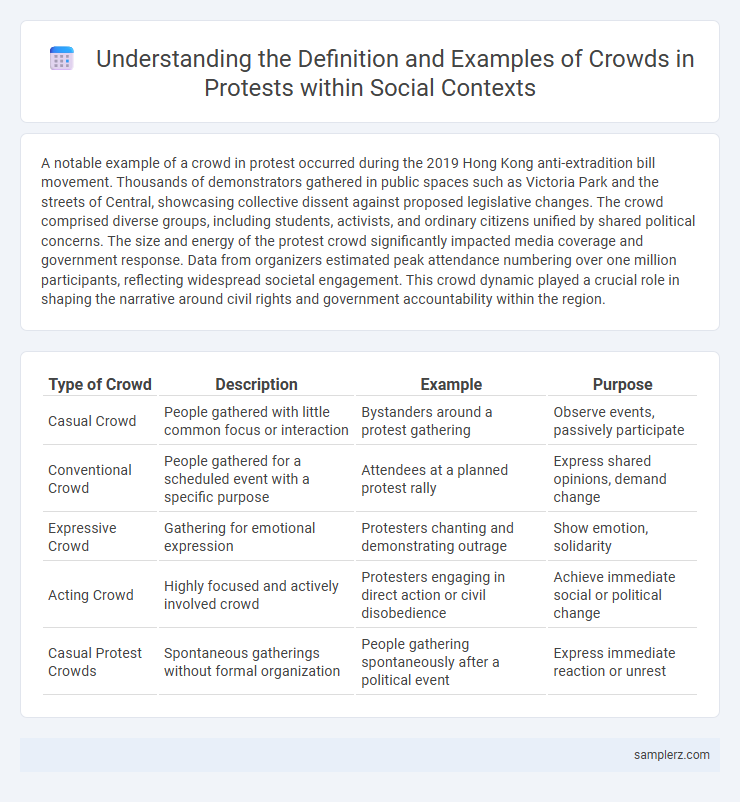A notable example of a crowd in protest occurred during the 2019 Hong Kong anti-extradition bill movement. Thousands of demonstrators gathered in public spaces such as Victoria Park and the streets of Central, showcasing collective dissent against proposed legislative changes. The crowd comprised diverse groups, including students, activists, and ordinary citizens unified by shared political concerns. The size and energy of the protest crowd significantly impacted media coverage and government response. Data from organizers estimated peak attendance numbering over one million participants, reflecting widespread societal engagement. This crowd dynamic played a crucial role in shaping the narrative around civil rights and government accountability within the region.
Table of Comparison
| Type of Crowd | Description | Example | Purpose |
|---|---|---|---|
| Casual Crowd | People gathered with little common focus or interaction | Bystanders around a protest gathering | Observe events, passively participate |
| Conventional Crowd | People gathered for a scheduled event with a specific purpose | Attendees at a planned protest rally | Express shared opinions, demand change |
| Expressive Crowd | Gathering for emotional expression | Protesters chanting and demonstrating outrage | Show emotion, solidarity |
| Acting Crowd | Highly focused and actively involved crowd | Protesters engaging in direct action or civil disobedience | Achieve immediate social or political change |
| Casual Protest Crowds | Spontaneous gatherings without formal organization | People gathering spontaneously after a political event | Express immediate reaction or unrest |
Defining a Protest Crowd: Key Characteristics
A protest crowd typically consists of a large, organized group of individuals united by a common cause or grievance, expressing dissent through collective action. Key characteristics include shared purpose, emotional intensity, and coordinated behavior aimed at drawing public attention or influencing policy. Such crowds often exhibit high levels of solidarity, chanting slogans, carrying signs, and engaging in symbolic gestures to amplify their message.
Historical Examples of Protest Crowds
The 1963 March on Washington for Jobs and Freedom drew over 250,000 participants advocating for civil rights and economic equality. In 1989, millions gathered in Tiananmen Square, Beijing, demanding political reform and greater freedoms before the government crackdown. The 2011 Arab Spring protests mobilized vast crowds across Tunisia, Egypt, and other nations, catalyzing widespread political upheaval and regime changes.
Notable Global Protest Crowds in Recent Years
Millions gathered in Hong Kong's 2019 pro-democracy protests, marking one of the largest and most sustained movements in the city's history. The 2017 Women's March in Washington D.C. drew over 4 million participants worldwide, advocating for women's rights and social justice. Brazil's 2013 protests saw crowds exceeding 1 million, ignited by public transportation fare hikes and expanding into demands for broader political reform.
Crowd Dynamics in Social Movements
Crowd dynamics in social movements reveal how collective behavior emerges from individual actions, amplifying the impact of protests through emotional contagion and shared goals. As crowd density increases, coordination and unified chants or gestures enhance visibility and pressure on authorities. Understanding these dynamics helps organizers strategize mobilization and sustain momentum in social change efforts.
Influential Protest Crowds: Case Studies
The 2019 Hong Kong pro-democracy protests mobilized over two million participants, showcasing a powerful example of sustained, peaceful civil resistance that influenced global attention and policy discussions. The 2020 Black Lives Matter protests in the United States united millions across hundreds of cities, leveraging social media to amplify calls for racial justice and police reform. These influential protest crowds demonstrate how collective action, strategic organization, and widespread participation can drive social change and reshape public discourse.
The Role of Social Media in Crowd Mobilization
Social media platforms such as Twitter, Facebook, and Instagram have become pivotal tools in crowd mobilization for protests by enabling rapid information dissemination and coordination among participants. Hashtags like #BlackLivesMatter and #MeToo have amplified voices globally, fostering collective action and raising awareness on social justice issues. Real-time updates and live streaming empower protesters to organize effectively while documenting events, enhancing transparency and response strategies.
Peaceful vs. Aggressive Protest Crowds
Peaceful protest crowds utilize nonviolent methods such as chanting, holding signs, and forming human chains to advocate for social change, fostering community solidarity and drawing positive media attention. Aggressive protest crowds may escalate to property damage, confrontations with law enforcement, and disruptive behavior, which can shift public perception and lead to stricter security measures. Understanding the dynamics and motivations behind these protest types is crucial for policymakers and organizers aiming to balance civil liberties with public safety.
Crowd Organization and Leadership in Protests
Effective crowd organization during protests hinges on clearly defined leadership structures that coordinate participant actions and maintain order. Leaders often employ decentralized communication methods such as social media platforms and encrypted messaging apps to mobilize supporters and disseminate real-time instructions. Strategic planning enhances crowd cohesion, minimizing chaos and amplifying the protest's impact on social and political change.
Emotional Impact of Being in a Protest Crowd
The emotional impact of being in a protest crowd often includes a powerful sense of solidarity and collective purpose that amplifies individual voices. Participants frequently experience heightened adrenaline, which can lead to a deep feeling of empowerment and motivation for social change. This shared emotional energy fosters strong connections among protesters, reinforcing their commitment to the cause.
Government Responses to Protest Crowds
Government responses to protest crowds often include a range of strategies such as deploying law enforcement to monitor and control gatherings, implementing curfews to limit assembly, and using communication channels to address public grievances. In some cases, governments may engage in negotiations with protest leaders to seek peaceful resolutions and avoid escalation. Surveillance technologies and intelligence gathering are increasingly employed to anticipate and manage crowd dynamics during mass demonstrations.

example of crowd in protest Infographic
 samplerz.com
samplerz.com